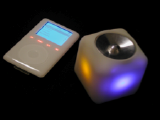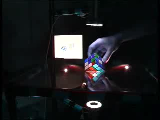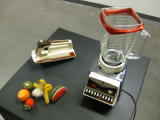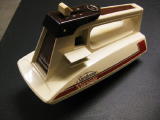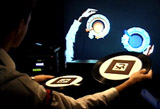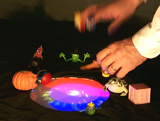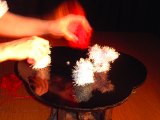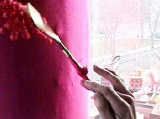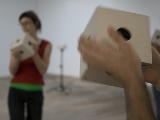Tangible Musical Artifacts
-
audio shaker
year: 2004
author(s): Mark Hauenstein,
Tom Jenkins
website: http://www.nurons.net/audioshaker/about.htm
Put simply, it is a tactile container to capture, shake up and pour out sounds. Anything sung, spoken, clapped, whistled or played near it is trapped inside, where it takes on an imagined yet tangible physicality. Sounds caught in this void are transformed, given weight and permanence, reacting directly to the shaker's movements, subtle or violent. Shaken sounds have to settle down before becoming still and silent, behaving more like fluid than transient energy. The linear timescale of sound is broken, a conversation is split into words and mixed up in the shaker, and can be poured out separately, tipped out in a simultaneous splash or added to and shaken up further.
-
Music Bottles
year: 1999
author(s): Hiroshi Ishii,
Ali Mazalek,
Jay Lee
affiliation: MIT Media Lab,
Tangible Media Group
publication: Bottles as a Minimal Interface to Access Digital Information [PDF]
website: http://tangible.media.mit.edu/projects/musicbottles/
musicBottles introduces a tangible interface that deploys bottles as containers and controls for digital information. The system consists of a specially designed table and three corked bottles that "contain" the sounds of the violin, a cello and a piano. Custom-designed electromagnetic tags embedded in the bottles enable each one to be wirelessly identified. The opening and closing of a bottle is also detected. When a bottle is placed onto the stage area of the table and the cork is removed, the corresponding instrument becomes audible. A pattern of colored light is rear-projected onto the table's translucent surface to reflect changes in pitch and volume. The interface allows users to structure the experience of the musical composition by physically manipulating the different sound tracks.
-
cubed
year: 2006
author(s): Douglas Edric Stanley
affiliation: Laboratoire Estéthique de l'Interactivité, Université de Paris 8
website: http://www.abstractmachine.net/blog/?p=152
cubed is a musical sequencer integrated into a Rubik's Cube®. By manipulating the colors on the cube, users generate different sound algorithms within the sequencer. Using specially-designed , math geeks can finally become the speedcubing breakcore supernerds they always feared were lurking underneath. cubed is working against the idea that a musician has to create music with audio software where building the musical algorithm and manipulating the digital algorithm are two different processes. Often, making digital music looks a lot like someone working on their spreadsheet. All of the notes of the musical process are visible and intrinsically intertwined. Using a universally known interface, a series of simple gestures cascade into a complex multitude of musical possibilities.
-
Beat Blender
year: 2009
author(s): Matti Niinimaki
website: http://originalhamsters.com/motion/mixedup.php
Beat Blender is a remixing instrument that takes tangible objects, chopping up sound samples quite literally. Select your favourite fruit, insert it into the Blender and hear what it sounds like. Add as many fruit as desired into the device and select a blending mode from 10 different options: Stir, Puree, Whip, Grate, Mix, Chop, Grind, Blend, Liquify, Frappé. The various fruits have an embedded RFID tag, with and associated sound sample, while the blender device has an embedded RFID reader to detect the presently used fruits.
-
Mixmaster 1200
year: 2009
author(s): Matti Niinimaki
website: http://originalhamsters.com/motion/mixedup.php
The Mixmaster 1200 is a wireless scratching device and an Arduino board equipped with an accelerometer and a bluetooth modem embedded into a vintage household mixer. Moving the Mixmaster from left to right scratches a sample, the top switch button acts as a crossfader.
-
augmented groove
year: 2000
author(s): Ivan Poupyrev,
Rodney Berry,
Jun Kurumisawa
affiliation: Advanced Telecomminication Research Institute, Sony CSL
publication: Collaborative Jamming in Augmented Reality [PDF]
Augmented Groove is a musical interface for
electronic music and, more specifically, techno dance music. Augmented
Groove uses augmented reality, 3D interfaces, and physical, tangible
interface technologies to allow performers to conduct multimedia
musical performances. The performer modulates and mixes compositions by
manipulating real LP records. The motions of the records control
filters, effects and samples dynamically mixed in and out of the
groove. A composer can assign any element of composition to any record
and the song progression is controlled simply by removing one record
and bringing in another. Effects, filters and sample triggering are all
assigned to any of the four record movements (figure below) and can be
controlled interactively using simple physical records rather than
numerous dials and sliders.
-
musical trinkets
year: 2000
author(s): Kai-yuh Hsiao,
Joe Paradiso
affiliation: MIT Medialab,
Responsive Environments Group
publication: Tangible Music Interfaces Using Passive Magnetic Tags [PDF]
website: http://www.media.mit.edu/resenv/sweptRF.html
This project has developed a tag reader
optimized for applications in human-computer interaction. It sweeps
through a 50-300 kHz read frequency, flagging any magnetically-coupled
resonators in that range. It is a minimally-complicated circuit, and is
able to provide the center frequency, resonance width, and amplitude
for each detected resonance over a serial line at 30 Hz continuous
updates. The tags are easily fashioned, consisting only of an inductor
and capacitor or magnetostrictor tag cut to appropriate length. We have
written an engaging graphical/musical application to demonstrate the
system using one coil, tagging over 11 different objects and tracking
their proximity and state to launch or modify musical sounds and
graphics. Furthermore, work on a six-coil version of this project is in
progress in order to enable gathering of three-dimensional position and
rotation information of tags.
-
Musical Navigatrics
year: 2002
author(s): Laurel Pardue,
Joe Paradiso
affiliation: Responsive Environments Group,
MIT Media Laboratory
publication: New Musical Interactions with Passive Magnetic Tags [PDF]
website: http://www.media.mit.edu/resenv/Navigatrics/
Musical Navigatrics is a musical interface based on electromagnetic tagging technology, where an ensemble of passively tagged objects is identified and tracked in real time when placed in the vicinity of a reader. As the system is able to identify and update the state of many (30 or more) tags simultaneously, they can be used together in any combination - e.g., several can sit on a surface at fixed distances from the reader while others can be handheld or worn by a single user or multiple performers. This interface is able to detect both free gesture (position and orientation of the objects) as well as local or
tactile variables (e.g. pressure). Musical Navigatrics enable dynamic overdubbing and control of complex musical sequences and sonic textures.
-
The Sound of Touch
year: 2007
author(s): David Merrill,
Hayes Raffle
affiliation: Tangible Media Group,
MIT Medialab, Boston
publication: MIT_soundoftouch.pdf [PDF]
website: http://www.rafelandia.com/sound%20of%20touch/
The Sound of Touch is a new instrument for real-time capture and sensitive physical stimulation of sound samples using digital convolution.A hand-held wand can be used to record sound and then playback the recording by brushing, scraping, striking or otherwise physically manipulating the wand against physical objects. During playback, the recorded sound is continuously filtered by the acoustic interaction of the wand and the material being touched. A texture kit allows for convenient acoustic exploration of a range of materials.
-
babbling/sounding/noising cubes
year: 2008
author(s): Catherine Bechard,
Sabin Hudon
website: http://www.bechardhudon.com/bechardhudon_Cubes_en.html
Babbling/sounding/noising cubes contain a multitude of sounds - fragments of life and of time-space that can be mixed and combined together. In the course of manipulating the cubes, unexpected and unpredictable sound associations and entanglements are created. Each cube contains an electronic device with sound samples on six independent channels - one per side - and an accelerometer that reads the cube's position. Every cube has its predetermined theme, of which each of its faces comprises one characteristic. For instance different sounds produced by the human body: sigh, respiration, hesitation, mastication, snuffling, cracking of the body. Visitors are invited to investigate and explore this environment by manipulating the cubes that are distributed in the exhibition space.
-
MusicCube
year: 2004
author(s): Miguel Bruns Alonso
affiliation: TU Delft,
ID-Studiolab
publication: MusicCube: making digital music tangible [PDF]
The MusicCube is a rubber cube-like object with a button shaped as a speaker that can be pressed and rotated. Four of the six sides of the cube represent play lists and the user can define their color. By playing with the cube users interact with their music. To skip or rewind the user squeezes the cube; the harder he or she squeezes it the faster it will move through the play list. By shaking the cube a randomly chosen song will be played etc.
